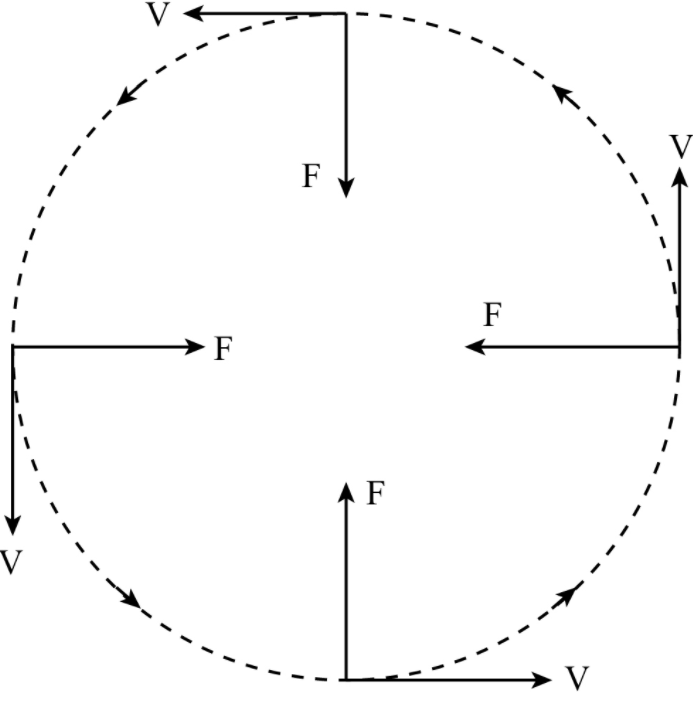
In uniform circular motion the velocity is
(A) Constant
(B) Variable
(C)
(D) None
Answer
488.1k+ views
Hint: To give the answer this question, we must know about the concept of circular motion, and it is also required to understand which variable is constant and which one is varying.
Complete step by step answer:If the object is moving with constant speed then the object and that too in a circular path, then it is said to be in uniform circular motion. In the uniform circular motion the speed is constant but velocity changes.
When any object is moving in circular then there is an acceleration which acts toward the center and this acceleration is responsible to move the object around the center.

This acceleration is perpendicular to the velocity of a particle at every instant, and it is only changing the direction of velocity and not magnitude and that’s why the motion is uniform circular motion. This acceleration is known as centripetal acceleration or radial acceleration. The force acting towards the centre is called centripetal force.
The centripetal or radial acceleration is given by,
Here,
As we know that the velocity is a vector quantity because it has both a magnitude and a direction. The magnitude of the velocity vector represents the instantaneous speed of the object. The direction of the velocity vector is always directed toward the same direction in which the object is moving. As we know that in uniform circular motion the object is moving in circular path so its direction is continuously changing
As the object rounds the circle, the direction of the velocity vector is different than it was the instant before. So while the magnitude of the velocity vector may be constant, the direction of the velocity vector is changing.
Hence, velocity is variable in uniform circular motion.
Note:We must know the difference in the speed and velocity while answering this problem, because in the circular motion the speed is constant while velocity is varying due to variation in direction.
Complete step by step answer:If the object is moving with constant speed then the object and that too in a circular path, then it is said to be in uniform circular motion. In the uniform circular motion the speed is constant but velocity changes.
When any object is moving in circular then there is an acceleration which acts toward the center and this acceleration is responsible to move the object around the center.

This acceleration is perpendicular to the velocity of a particle at every instant, and it is only changing the direction of velocity and not magnitude and that’s why the motion is uniform circular motion. This acceleration is known as centripetal acceleration or radial acceleration. The force acting towards the centre is called centripetal force.
The centripetal or radial acceleration is given by,
Here,
As we know that the velocity is a vector quantity because it has both a magnitude and a direction. The magnitude of the velocity vector represents the instantaneous speed of the object. The direction of the velocity vector is always directed toward the same direction in which the object is moving. As we know that in uniform circular motion the object is moving in circular path so its direction is continuously changing
As the object rounds the circle, the direction of the velocity vector is different than it was the instant before. So while the magnitude of the velocity vector may be constant, the direction of the velocity vector is changing.
Hence, velocity is variable in uniform circular motion.
Note:We must know the difference in the speed and velocity while answering this problem, because in the circular motion the speed is constant while velocity is varying due to variation in direction.
Latest Vedantu courses for you
Grade 11 Science PCM | CBSE | SCHOOL | English
CBSE (2025-26)
School Full course for CBSE students
₹41,848 per year
Recently Updated Pages
Master Class 11 Economics: Engaging Questions & Answers for Success

Master Class 11 Business Studies: Engaging Questions & Answers for Success

Master Class 11 Accountancy: Engaging Questions & Answers for Success

Master Class 11 English: Engaging Questions & Answers for Success

Master Class 11 Computer Science: Engaging Questions & Answers for Success

Master Class 11 Maths: Engaging Questions & Answers for Success

Trending doubts
State and prove Bernoullis theorem class 11 physics CBSE

1 ton equals to A 100 kg B 1000 kg C 10 kg D 10000 class 11 physics CBSE

State the laws of reflection of light

One Metric ton is equal to kg A 10000 B 1000 C 100 class 11 physics CBSE

Difference Between Prokaryotic Cells and Eukaryotic Cells

1 Quintal is equal to a 110 kg b 10 kg c 100kg d 1000 class 11 physics CBSE




